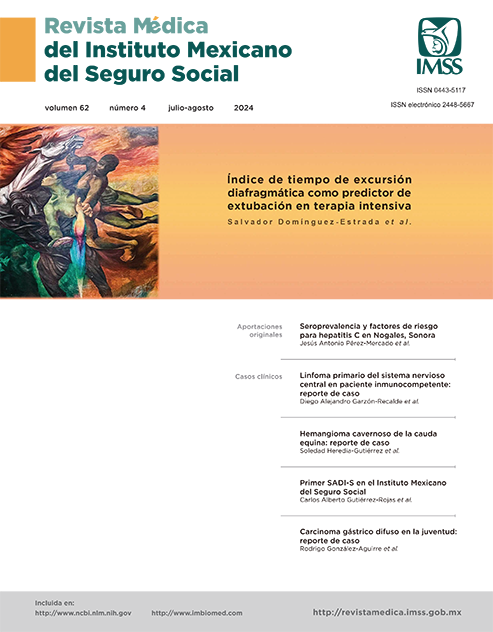Cavernous hemangioma of the cauda equina: A case report
Main Article Content
Keywords
Hemangioma, Cavernous, Spinal Nerves, Low Back Pain
Abstract
Background: Cavernous hemangiomas are vascular malformations formed by groups of dilated sinusoids, organized in channels with a single layer of endothelium. Cavernous hemangiomas represent only 3% of all intradural lesions, and of these 5-12 % correspond to spinal cord lesions and those of the cauda equina are rare.
Clinical case: A 57 years-old male patient is presented , without history of radiotherapy, who showed low back pain and contracture of the dorsal and paraspinal muscle during 6 months, evaluated in another hospital and diagnosed with a lumbar disc herniation, he was managed with analgesics and physiotherapy for two months, however the theraphy failed, the symptoms worsened and dysesthesias appeared in the gluteal and perianal region, with reduction of strength in both legs with predominance in the left leg, as well bladder sphincter dysfunction. A simple magnetic resonance imaging of the lumbosacral spine was performed, revealing an intraspinal and intradural lesion at the L1-2 level. He was diagnosed with cauda equina syndrome and surgery was carried out. After surgery the patient presented clinical improvement and resolution of symptoms. During follow-up in the outpatient clinic, one month after surgery, the patient was able to walk independently and is currently asymptomatic. The pathological anatomy result reported a cavernous hemangioma.
Conclusions: Cavernous hemangiomas of the cauda equina are rare, and when they are associated with a cauda equina syndrome, early surgery is recommended like the first option treatment to avoid permanent neurological injury.
References
Ridley LJ, Han J, Ridley WE et al. Cauda equina: Normal anatomy. J Med Imaging Radiat Oncol. 2018;62 Suppl 1:123. doi: 10.1111/1754-9485.04_12786.
Vicenty JC, Fernandez-de Thomas RJ, Estronza S et al. Cavernous Malformation of a Thoracic Spinal Nerve Root: Case Report and Review of Literature. Asian J Neurosurg. 2019;14 (3):1033-1036. doi: 10.4103/ajns.AJNS_249_18.
Patet G,Bartuli A, Meling TR et al. Natural history and treatment options of radiation-induced brain cavernomas:a systematic review. Neurosurg Rev. 2022;45(1):243-251. doi: 10.1007/ s10143-021-01598-y.
Koester SW, Scherschinski L, Srinivasan VM et al. Radiation-induced cavernous malformations in the spine: patient series. J Neurosurg Case Lessons. 2023;5(23). doi: 10.3171/ CASE22482.
Riolo G, Ricci C, Battistini S. Molecular Genetic Features of Cerebral Cavernous Malformations (CCM) Patients: An Overall View from Genes to Endothelial Cells. Cells. 2021;10(3):704. doi: 10.3390/cells10030704.
Hong T, Xiao X, Ren J, et al. Somatic MAP3K3 and PIK3CA mutations in sporadic cerebral and spinal cord cavernous malformations. Brain. 2021;144(9):2648-2658. doi: 10.1093/brain/ awab117.
Nie QB, Chen Z, Jian FZ et al. Cavernous angioma of the cauda equina: a case report and systematic review of the literature. J Int Med Res. 2012;40(5):2001-2008. doi:10. 1177/030006051204000542.
Caroli E, Acqui M, Trasimeni G et al. A case of intraroot cauda equina cavernous angioma: clinical considerations. Spinal Cord. 2007;45(4):318-321. doi: 10.1038/sj.sc.3101964.
Albalkhi I, Shafqat A, Bin-Alamer O et al. Long-term functional outcomes and complications of microsurgical resection of brainstem cavernous malformations: a systematic review and meta-analysis. Neurosurg Rev. 2023;46(1):252. doi: 10.1007/ s10143-023-02152-8.
Liao D, Wang R, Shan B et al. Surgical outcomes of spinal cavernous malformations: A retrospective study of 98 patients. Front Surg.2023;9:1075276. doi: 10.3389/fsurg.2022.1075276.
Yang T, Wu L, Yang C et al. Cavernous angiomas of the cauda equina: clinical characteristics and surgical outcomes. Neurol Med Chir (Tokyo). 2014;54(11):914-923. doi: 10.2176/nmc. oa.2014-0115.
Khalatbari MR, Hamidi M, Moharamzad Y et al. Cauda equina cavernous angioma presenting as acute low back pain and sciatica. A report of two cases and literature review. Neuroradiol J. 2011;24(4):636-642. doi: 10.1177/197140091102400421.
Kumar V, Nair R, Kongwad L et al. Cavernous haemangioma of the cauda region: case report and review of literature. Br J Neurosurg. 2017;31(5):614-615. doi: 10.1080/02688697. 2016.1199784.
Takeshima Y, Marutani A, Tamura K et al. A case of cauda equina cavernous angioma coexisting with multiple cerebral cavernous angiomas. Br J Neurosurg. 2014;28(4):544-546. doi: 10.3109/02688697.2013.841856.
Yaltirik K, Özdoğan S, Doğan Ekici I et al. Cauda equina cavernous hemangioma: very rare pediatric case. Childs Nerv Syst. 2016;32(12):2289-2291. doi: 10.1007/s00381-016-3286-9.
Golnari P, Ansari SA, Shaibani A et al. Intradural extramedullary cavernous malformation with extensive superficial siderosis of the neuraxis: Case report and review of literature. Surg Neurol Int. 2017;8:109. doi: 10.4103/sni.sni_103_17.
Apostolakis S, Mitropoulos A, Diamantopoulou K et al. Cavernoma of the cauda equina. Surg Neurol Int. 2018;9:174. doi: 10.4103/sni.sni_212_18.
Naleer H, Manivel M, Bathala R et al. Lumbar spinal nerve root cavernoma: A rare cause of Intradural extramedullary lesion–Case report. Interdisciplinary Neurosurgery 32 (2023): 101737.doi: 10.1016/j.inat.2023.101737.
Hart BL, Mabray MC, Morrison L et al. Systemic and CNS manifestations of inherited cerebrovascular malformations. Clin Imaging. 2021;75:55-66. doi: 10.1016/j.clinimag.2021.01.020.
Bennett SJ, Katzman GL, Roos RP et al. Neoplastic cauda equina syndrome: a neuroimaging-based review. Pract Neurol. 2016;16(1):35-41. doi: 10.1136/practneurol-2015-00123.


